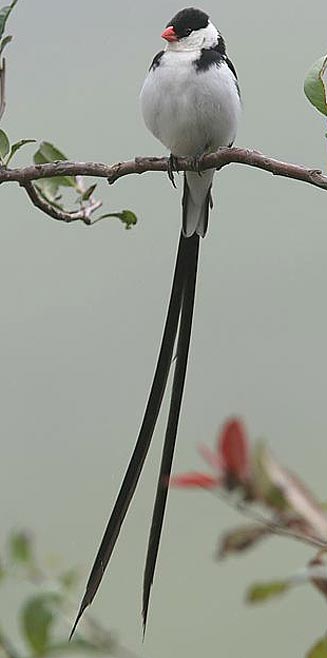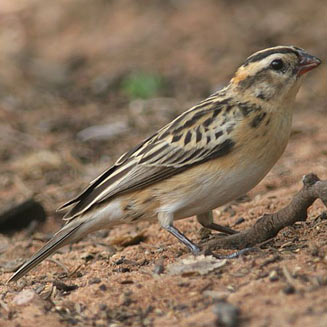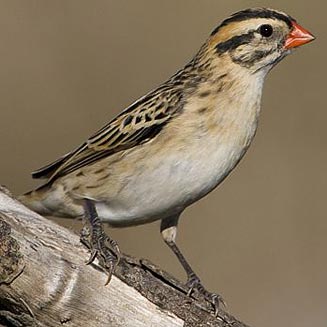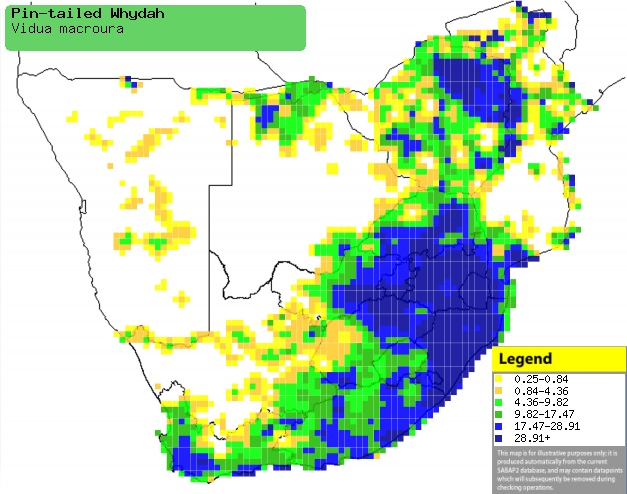|
Vidua macroura (Pin-tailed
whydah)
Koningrooibekkie [Afrikaans]; Uhlakhwe, Ujobela [Xhosa];
uHlekwane [Zulu]; Harusira (generic term for whydahs) [Kwangali]; ’Mamarungoana,
Selahlamarungoana, Selahlamarumo [South Sotho]; Mutsetse, Tsikidzamutsetse [Shona];
N'waminungu [Tsonga]; Dominikaner-wida [Dutch]; Veuve dominicaine [French];
Dominikanerwitwe [German]; Viuvinha [Portuguese]
Life
> Eukaryotes >
Opisthokonta
> Metazoa (animals) >
Bilateria >
Deuterostomia > Chordata >
Craniata > Vertebrata (vertebrates) > Gnathostomata (jawed
vertebrates) > Teleostomi (teleost fish) > Osteichthyes (bony fish) > Class:
Sarcopterygii (lobe-finned
fish) > Stegocephalia (terrestrial
vertebrates) > Tetrapoda
(four-legged vertebrates) > Reptiliomorpha > Amniota >
Reptilia (reptiles) >
Romeriida > Diapsida > Archosauromorpha > Archosauria >
Dinosauria
(dinosaurs) > Saurischia > Theropoda (bipedal predatory dinosaurs) >
Coelurosauria > Maniraptora > Aves
(birds) >
Order: Passeriformes > Family: Viduidae
|
 |
 |
 |
|
Pin-tailed whydah male, in non-breeding plumage,
Ntsikeni Nature Reserve, South Africa. [photo
Trevor Hardaker ©] |
Top right: Pin-tailed whydah female, Nylsvlei,
South Africa. [photo Trevor Hardaker ©]
Bottom right: Pin-tailed whydah male in
non-breeding plumage, Milnerton Sewage Works, South Africa. [photo Trevor Hardaker ©] |
Distribution and habitat
Occurs across sub-Saharan Africa, from Senegal to Ethiopia
south to southern Africa, where it is common across Zimbabwe, South Africa,
patches of Mozambique and northern and eastern Botswana, while more scarce in
Namibia. It generally prefers grassland, open savanna woodland, hillsides with
scattered trees and bushes, sedges and rank grass along watercourses, cultivated
croplands and gardens.
|
 |
|
Distribution of Pin-tailed whydah in southern
Africa, based on statistical smoothing of the records from first SA Bird
Atlas Project (©
Animal Demography unit, University of
Cape Town; smoothing by Birgit Erni and Francesca Little). Colours range
from dark blue (most common) through to yellow (least common).
See here for the latest distribution
from the SABAP2. |
Predators and parasites
It has been recorded as prey of Elanus caeruleus
(Black-shouldered kite).
Food
It mainly eats grass seeds either take directly or
uncovered in the soil by scratching. It forages either singly or in
mixed-species flocks along with other granivorous species toward whom it is very
aggresive, chasing birds up to the size of doves away from food sources. The following food items have been recorded
in its diet:
- Grass seeds
- Panicum maximum (Guinea grass)
- Paspalum distichum (Water couch)
- Echinochloa
- Urochloa
- Setaria
- Filamentous algae
-
Termite alates
Breeding
- It is a polygynous brood parasite, with each male assuming a territory
centered on a perch, which it uses for calling and displaying. It is highly
defensive of its territory, chasing out other males as well as other species
and regularly displaying in an attempt to woo females. Successful males
often have a permanent source of food and water within their territory,
allowing them to display more frequently thus attract more females.
- Its main host is Estrilda astrild (Common
waxbill), but it may also parasitise the nests of the following bird
species:
- Egg-laying season in the Western Cape is from August-November, peaking
from September-October, while in summer rainfall areas it is later, from
November-April and peaking from December-March.
- The female often removes and eats any eggs laid by its host before
laying one or two of its own, parasitising in sets of one nest per day over
a period of 2-4 days, usually laying about 25 eggs in total in the breeding
season.
- The chicks hatch after an incubation period of about 11 days, and are
sometimes reared along with young waxbills. They eventually leave the nest
after about 17-21 days, staying with the waxbill family group for at least
another week or so before joining a whydah flock.
Threats
Not threatened, in fact it is common and widespread.
References
-
Hockey PAR, Dean WRJ and Ryan PG 2005. Roberts
- Birds of southern Africa, VIIth ed. The Trustees of the John Voelcker
Bird Book Fund, Cape Town.
|
